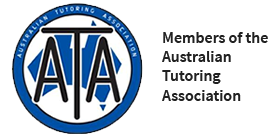There are 5 key skills required for a child to become a reader
Unlike speaking, reading does not come easily or naturally to children. For a child to learn to read, they must be taught clearly and in a defined sequence. Correctly sounding out words (decoding) and understanding what words mean (comprehension) are the two broad skills every child needs to become a reader.
Broadly, the 5 skills a child needs are:
1. Phonemic awareness 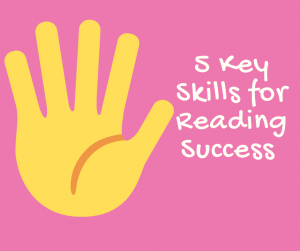
2. Phonics
3. Fluency
4. Vocabulary
5. Comprehension
Phonological awareness – a broad umbrella term that involves many skills
- Phonological awareness is the understanding that words can be broken down into sounds that have different meanings.
- It is made up of a group of skills and involves the ability to recognise and manipulate sounds in spoken language.
- It is a broad skill set that allows children to break up spoken words into sounds.
- Children who have phonological awareness skills can clap out the syllables in a word (hos-pi-tal)
- They can do things like rhyme “cat, sat, mat”
- They also recognise that words can have the same initial sounds such as the ‘f’ in ‘frog’ and ‘fish.’
Early phonological awareness
A child’s phonological awareness prior to starting school is one of the most important predictors of their later reading success. Phonological awareness should be a key feature of early literacy programs.
Awareness of rhythm and rhyme
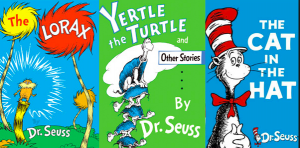
Phonological skills develop in steps. Children first realise rhymes in songs and can clap along to the syllables. It also involves noticing how sounds repeat themselves and sound the same at the end (alliteration). This rhyming aspect of English is why so many young children enjoy Dr. Seuss and nursery rhymes.
Rhyming is a critical skill as it indicates that the young child has identified specific features of spoken English. Research from the past 20 years shows that rhyming games and nursery rhymes helps pre-schoolers learn sound similarities in language.
This is an important step prior to reading and understanding that squiggly drawings correspond to sounds. Rhyme has a significant role to play in emerging literacy skills.
Required phonological skills in learning to read are:
- Being able to clap beats in a word
- Recognising and making rhymes
- Identifying separate sounds in words
- Separating and manipulate separate sounds in words
1. Phonemic Awareness – the most important of the phonological skills
Your child’s phonemic awareness on entering school is the single most powerful determinant of success he/she will experience in learning to read.
What is phonemic awareness?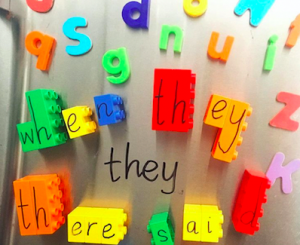
Phonemic awareness is the ability to hear individual sounds (phonemes) in words. Children need to be aware that spoken words are made up of sounds.
The word ‘sat’ has three phonemes – ‘/s/ /a/ /t.’ To successfully learn to read, children must learn to make a link between sounds and letters.
There are 44 phonemes in English – including sound combinations like ‘th.’
Phonemic awareness is absolutely essential in learning to read. A strong relationship has been established between phonemic skills and later reading. Even when intelligence and memory are considered, phonemic awareness is the strongest predictor of learning to read.
Important Phonemic Awareness sub-skills:
Segmenting
Segmenting and blending work together in emerging literacy. Blending sounds together to make words and segmenting words into sounds needs to be taught and practised. These skills are difficult to master, but can be achieved with explicit teaching and practice.
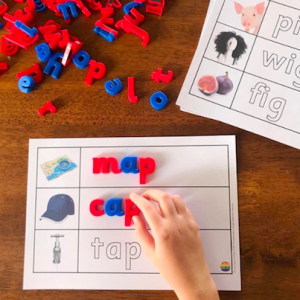
Blending
Blending words involves saying sounds in a sequence and also blending them together to say a word (reading). For example, using the same sounds /b/ /i/ /g/ to hear and say the word big.
These skills go together as we sound out the phonemes /bbbb/ /iiiii/ /gggg/ and then join them together to make big.
Blending and segmenting are the most important of all the phonemic skills. (National Reading Panel, 2000).
Isolation
The ability to hear each separate sound in a syllable.
For example, the first sound in the word soon is /s/ and the last sound is /n/.
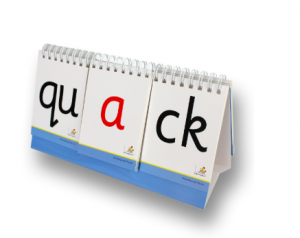
Alliteration
The ability to hear the first phoneme in a syllable or word. That is, the /d/ in dad. Identifying the first phoneme is a critical step in breaking words down into their separate parts.
Letter-sound knowledge – the alphabetic principle
The understanding that spoken words are made up of sounds that are represented by letters.
Required skills
- Clapping beats in words
- Recognising rhyming patterns
- Detecting the separate sounds in words
- Separating and manipulating the separate sounds in words
2. Phonics – sounds
Phonics is the relationship between sounds and their letter symbols.
It is the process of using letters and their sounds to sound out (decode) words. 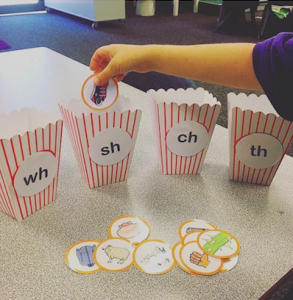
For example, it is knowing that ‘ea’ can make a short ‘e’ sound as in the word ‘bread,’ and using that knowledge to sound out similar words, like ‘head.’
The awareness of sounds and how they are represented in letters is an important part of learning to read. By learning the relationship between speech sounds and letter-symbols, children can use this code to read almost any word.
Letter sound knowledge = the alphabetic principle = phonics.
We start off teaching the spoken sounds of the alphabet, then introduce vowel teams or digraphs. This is when two vowels go together to form one sound – such as the /ai/ in the word ‘rain.’
Once clearly taught, phonic skills need immediate practice in reading.
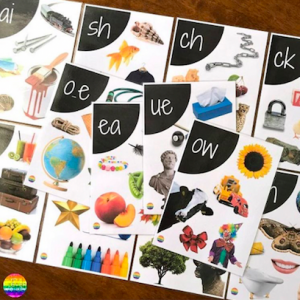
We teach systematic synthetic phonics at Learning Works,which has the most research to back up its use.
What on earth is systematic synthetic phonics?
When children learn synthetic phonics, they learn the associations between letters and their sounds in a clear sequence. Children also learn how to blend (putting sounds together to make words) and segmenting (sounding out words).
The role of sight words
Sight words refer to high frequency words that do not ‘play by the rules,’ and cannot be sounded out, so they must be recognised visually. Helping children learn high frequency words is a useful way to help children who struggle with their reading. Rapid word recognition is necessary for independent reading.
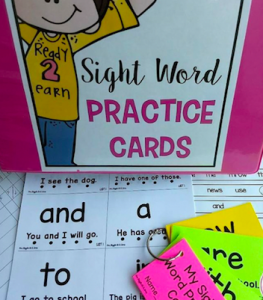
3. Fluency
Fluent reading shows a reader is confident, accurate and expressive. Fluent readers read rapidly and smoothly. Fluency is affected by familiarity with words and background knowledge of the text.
Fluency is important because it frees students to understand what they read and to read for meaning.
How to improve fluency:
1. Repeated reading with guidance:
Reading the same book again may be repetitive, but repeated reading improves word recognition, speed and fluency for your child.
2. Extensive independent reading
Good readers spend much more time reading than poor readers. Children benefit from regular reading, so great encouragement should be given to your child to read books at their reading level at home.
4. Vocabulary
Vocabulary knowledge is strongly related to reading skills and school achievement in general. The greater the vocabulary, the more chance there is that readers will recognise words as they attempt to decode them.
Young readers find it incredibly difficult to make sense of words that they have not heard before and that are not part of their vocabulary.
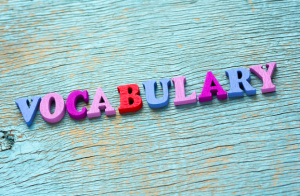
Building a wide and varied vocabulary is an important part of a reading program.
Children learn early words and develop their vocabulary from their parents, other adults they have contact with and family members. Readers find it very difficult to read words that are not already part of their oral vocabulary.
Beyond the importance of vocabulary development for reading, word knowledge has wider implications. It influences thinking, speaking and writing throughout a child’s life.
5. Comprehension
The final fundamental skill in your child’s reading process is comprehension – the reason for it all! Comprehension is the process where your child gains meaning from what they have read, and opens the door to a world of knowledge and creativity.
For beginner readers, the most common obstacle for comprehension is poor decoding of words first, followed by vocabulary.
Typically, reading comprehension improves as decoding skills advance. In children older than 10 years who struggle with comprehension – it becomes the most concerning focus.
Other factors that can cause difficulties in comprehension are:
- working memory
- making inferences
- a child’s ability to stay focused.
Good readers have purpose
Good readers know why they are reading, whether it is to work out how to make slime, read a recipe, work out how a video game works or research a topic for an assignment.
Good readers actively engage in the text
Good readers think about what they are reading, ask question, search for answers, and mentally picture events relating to the text. Good readers know when they have difficulties what they are reading and know what to do when that happens. Good readers become involved in their own reading processes.
Poor readers do not typically do these things. They do not use comprehension strategies efficiently.
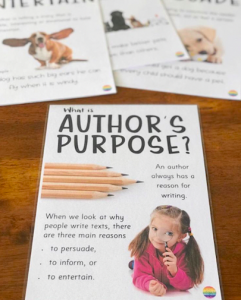
Comprehension is a skill that can be taught
Thankfully the evidence shows that comprehension can be improved when specific comprehension strategies are used.
Teachers can show children strategies that will help them develop the skill of identifying the purpose of reading by:
- accessing prior knowledge
- asking and answering questions as they read
- distinguishing major content from small details
- creating mental images as they read.
Tips for helping with teaching comprehension
Choose a variety of books, including short books
As adults, most of the reading we do is short newspaper articles, letters; emails; recipes, newsletters and so on. Yet much of the material that we ask our children to read is long. Including shorter paragraphs, sports stories, even materials like cartoons and jokes – are helpful.
Teach comprehension from the first stages of reading
Even before your child can sound out all words properly, you can start helping them with their comprehension. Teaching comprehension is really teaching thinking. Picture books can even be used to teach comprehension. Non-fiction picture books can convey an enormous amount of information through photographs, maps and diagrams.
Teach comprehension by reading to your children
Children beyond middle primary school still enjoy listening to stories. You can read at a level that is beyond their own reading level and expose them to more sophisticated vocabulary and language. You can model your own thinking as you determine the meaning of the text.
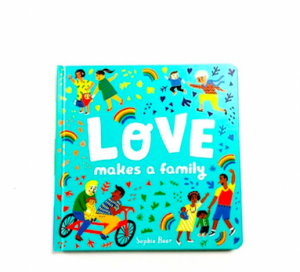
Important comprehension skills are:
- Clarifying the purpose of reading
- accessing prior knowledge
- organising new information into current knowledge
- distinguishing major content from details
- using a range of strategies to help understanding, such as rereading, confusing sections, creating mental images, taking notes, summarising, using concept maps and using a dictionary or thesaurus.

